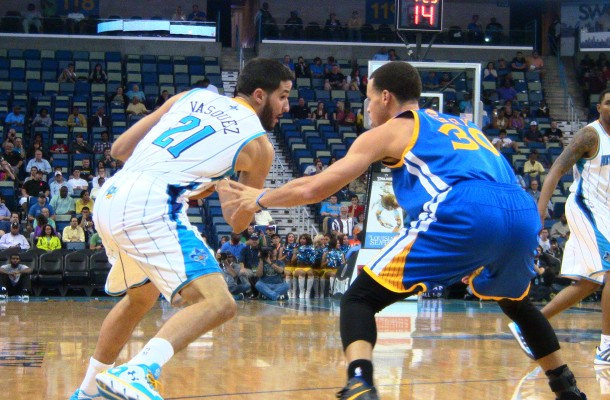« Road Losing Streak Continues as Hornets Lose to Warriors
Repo Rate: Starting Backcourt

Two weeks ago, I wrote a piece detailing what happens when Eric Gordon is missing shots- more specifically, how this result is affected by the nature of his shot. This post will work to establish some comparison for Gordon’s results, as the data was original and thus had no comparison. In case you did not read my previous article, click on this link. My explanation of how I gathered the data is there as well. All statistics are current as of April 3, so they do not include the Warriors game, and Gordon’s statistics are updated to reflect the games he’s played in since the original article.
The results
Going into my research for Vasquez, I believed that the Repo rate from Gordon’s missed shots would be a bit higher, but the results were actually very similar. They illustrate the same effect that we saw with Gordon: the Hornets are maintaining possession at a much higher rate when Vasquez is taking shots while moving towards the basket.
| Player | Shot Miss Type | Number of Occurences | Retained Possession | Lost Possession | Retained Possession Rate |
|---|---|---|---|---|---|
| Gordon | To Basket | 113 | 53 | 60 | 47% |
| Jumper | 157 | 47 | 110 | 30% | |
| Vasquez | To Basket | 299 | 134 | 165 | 45% |
| Jumper | 199 | 48 | 151 | 24% |
Further Analysis
The video showed a big difference that my data cannot fully explain. Although the Hornets had similar Repo rates on shots by Gordon and Vasquez, there was a noticeable difference in how it was happening. To assist in my analysis, I gathered some data from nbawowy.com
Gordon: takes 30 percent of his shots from 0-3 feet; 15 percent of his shots from 4-9 feet
Vasquez: takes 25 percent of his shots from 0-3 feet; 30 percent of his shots from 4-9 feet
This data illustrates what I saw in the video. Vasquez takes many more shots from the range just outside of the basket. His size allows him to get off his floater versus almost any guard who defends him. Vasquez is using his floater in the 4-9 foot range, and teams have caught onto this, so opposing bigs are coming out to contest him. As these shots are being taken a few feet further than Gordon’s, Hornet bigs have more space around the rim to rebound. Conversely, the Hornets are keeping possession off of Gordon’s misses because he’s getting to the basket more quickly and the defense doesn’t have as much time to react.
Surprisingly, Gordon’s missed jumpers result in a better reposession rate than Vasquez’s. Vasquez has his faults, but he isn’t particularly prone to taking “bad” jumpers- stepbacks, contested jumpers, etc. In fact, a good percentage of his missed jumpers are resulting from getting the ball late in the shot clock. This is certainly related to his and other guards’ inabilities to get good offense initiated earlier, but it’s much harder to fault a bad shot that is taken to beat the shot clock.
The similarities in Vasquez’s data shows us that the high Repo rate from Gordon driving to the hoop may not be as impressive as we originally thought. Instead, it appears to further support the notion that driving to the hoop exerts more pressure on a defense and leads to a better rate of second chances. This still illustrates how important it is for the Hornets guards to get into the lane and force the defense to contest shots.
These high rates could result from the offensive rebounding ability of the Hornet bigs. I will analyze data from the Denver Nuggets sometime in the near future to give this data some outside comparison. The Nuggets sport one of the best offensive rebounding rates in the league, so their data would likely give us a better idea of how impressive the 47% and 45% Repo rates from Gordon and Vasquez (moving to the basket) really are.
Other Observations
-Robin Lopez grabs an inordinate percentage of Vasquez’s shots. By my estimate, Lopez must grab roughly 75 percent of the offensive rebounds resulting from Vasquez misses, and it’s for a specific reason: he is often Vasquez’s pick and roll partner. Lopez’s lack of foot speed, coupled with Vasquez’s slow pace, allows him to arrive at the rim at the perfect time for putback opportunities. Even if he gets there too quickly, because Vasquez is drawing Lopez’s man, Lopez can use his body to seal whichever smaller defender rotates to him and grab the putback without exerting considerable effort.
-It has been a few weeks since my Gordon research, but I would theorize that Lopez would grab offensive rebounds at a lesser rate on Gordon pick and rolls than he does when executing them with Vasquez, because Lopez may not be quick enough to arrive for Gordon misses at the opportune time. This is something that I may look into for the future for Gordon- how the speed and size of the man setting the screen affects the Repo rate.





Pingback: Eric Gordon: eHarmony | New Orleans Hornets | Hornets247.com